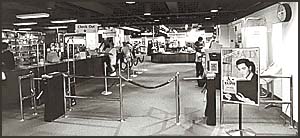Management
Camden County Library’s methodical planning and management breeds confidence, but in the business of running a library, problems invariably crop up and the best laid plans may not stay on schedule. In her capacity as library director, Sumler leads the library down specific paths, mapped to enable the library to reach its intended destination by means of careful planning, attention to details, and open lines of communication. Sumler has a realistic attitude about what can be accomplished and what cannot. “Sometimes,” she says, “there is no exact fix for things.” She has created a climate conducive to experimentation and risk-taking that enables the library’s workers to explore new avenues and develop new ideas. Under her guidance, library staff members take pains to ensure equitable access but, as she explains, always on a reasonable basis. Her efforts, she says, are directed primarily toward “getting everyone to be more customer oriented.”
“What the customer wants and needs are the guiding factors.”
-Claudia Sumler
 The Main Desk
The Main Desk
“What the customer wants and needs are the guiding factors,” says Sumler. Toward that end, the library has relied on needs assessments, market surveys, focus groups, and community evaluations to provide direction for its programs, particularly for CamNet. Although CamNet was not included as an explicit element in the library’s strategic plan, it fulfills several major goals in the plan by means of its careful conception and implementation.
Being ready to respond when opportunity calls is something that the Camden County Library is proud of and claims to have done often. Its best example, however, is CamNet, which began in the educational sphere of the county government but which has now found a permanent home in the main library. At the time of its formation, there was no specific plan for an electronic link among the library and the county’s schools; none of the institutions had a budget for such a project. It was, finally, the investment of staff time among all the partners–the library, schools, and Garden State Cable–that made CamNet possible and got it up and running. The library became central to CamNet’s operations, largely because the library was willing to take on the project and had an experienced and willing staff to do the work. There were no models to follow for what had to be done, how it should be done, or to what extent the library should be doing it. Sumler admits, “It all made everyone very nervous.” But trust, she says, got the network going and kept it going–trust between the library and its partners.

